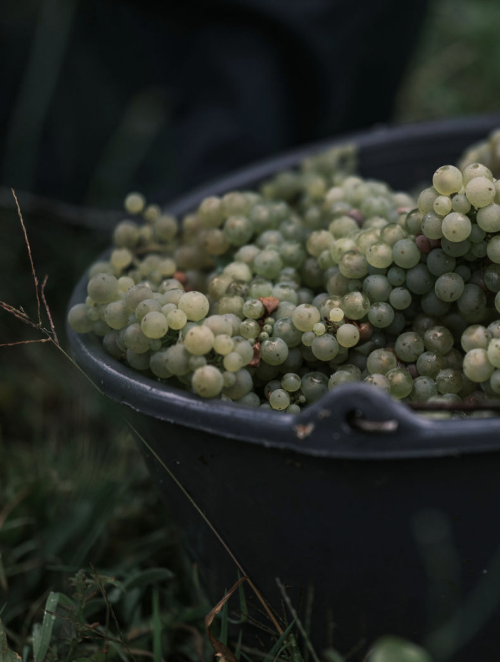
Fruity Saar wines – experience the region's specialties with Kabinett & Co!
Fruity Saar wines have been the absolute forte of the region for over a century. Hardly any other wine-growing region is still dedicated to the production of magnificent sweet wines with such great devotion.
Over 100 years ago, the sweet Rieslings from our top vineyards such as Scharzhofberger, Ockfener Bockstein or Ayler Kupp were considered among the best and most expensive wines in the world. Unfortunately, due to the two World Wars and the glycol scandal of the 1980s, sweet wines fell somewhat into disrepute both nationally and internationally. Today, our fruity Saar wines are enjoying increasing popularity again, as many appreciate their full-bodied taste with very low alcohol content. Basically, there are two types of fruity Saar wines: fruity quality wines (enriching the fermenting must with sugar is permitted) and fruity predicate wines (enrichment is not permitted) in the form of fruity-sweet Kabinett wines.
Order the fruity Saar wines from our top winemakers at winemaker prices from us below.
Fruity Saar wines – experience the region's specialties with Kabinett & Co!
Fruity Saar wines have been the absolute forte of the region for over a century. Hardly any other wine-growing region is still dedicated to the production of magnificent sweet wines with such great devotion.
Over 100 years ago, the sweet Rieslings from our top vineyards such as Scharzhofberger, Ockfener Bockstein or Ayler Kupp were considered among the best and most expensive wines in the world. Unfortunately, due to the two World Wars and the glycol scandal of the 1980s, sweet wines fell somewhat into disrepute both nationally and internationally. Today, our fruity Saar wines are enjoying increasing popularity again, as many appreciate their full-bodied taste with very low alcohol content. Basically, there are two types of fruity Saar wines: fruity quality wines (enriching the fermenting must with sugar is permitted) and fruity predicate wines (enrichment is not permitted) in the form of fruity-sweet Kabinett wines.
Order the fruity Saar wines from our top winemakers at winemaker prices from us below.
last seen
Commented [MK1]: Take a nice landscape picture from the photoshoot!
Commented [MK2]: Everything above the line: above the products (Collections) -> introductory text about product overview
Everything below the line: SEO section below the products (Collections)
This contributes to creating a wide spectrum of sweet and fruity wines. An example of sweet and fruity wines are many Rieslings, especially those from German wine regions like the Saar. These wines can have aromas of ripe peaches, apples, and citrus fruits, accompanied by an appropriate sweetness that underlines the fruity character. The sweet-fruity combination is also found in dessert wines, such as a German Beerenauslese. These wines are characterized by intensely sweet aromas, shaped by fruits such as apricots, honey, and exotic fruits. For lovers of sweet and fruity wines, the variety is impressive, ranging from light and sparkling to opulent and complex wines. Whether as an accompaniment to desserts or as an independent enjoyment experience, sweet and fruity wines offer a taste journey for every wine lover!
1.
Label Information: The simplest method is often a glance at the label. Many wine labels provide information about the residual sugar content. Terms such as "dry" or "brut" indicate a low residual sugar content, while terms such as "semi-dry", "off-dry" or "sweet" indicate a higher residual sugar content.
2.
Alcohol content: A low alcohol content may indicate a higher residual sugar content. Sweet wines often have a slightly lower alcohol content because not all of the sugar is converted into alcohol during the fermentation process.
3.
Aroma profile: Fruit aromas can indicate sweetness. Wines with intense fruit aromas such as peach, pineapple or honey tend to be sweeter. At the same time, wines with citrus or green apple notes can be drier.
4.
Wine color: The color of the wine can also indicate sweetness. Generally, sweet white wines are often golden or amber-colored, while dry white wines are rather pale and clear.
5.
Tasting: The most obvious way is, of course, tasting. The first sip gives you a clear idea of the sweetness of the wine. If you are unsure, you can also ask a professional or sommelier for advice.
These factors can be used in combination to determine the perceived sweetness of a wine. However, keep in mind that taste is subjective, and personal preferences may vary.
Another prominent example is French Sauternes, which is especially famous for its sweet wines. Château d'Yquem, a Sauternes winery, is considered one of the best in the world and produces exquisitely sweet wines from the Sémillon grape.
In Austria, Trockenbeerenauslese (TBA) from the Burgenland region is a sweet wine of outstanding quality. These wines are made from overripe grapes affected by noble rot and offer a rich, sweet explosion of flavor.
Ultimately, the choice of the best sweet wine depends on individual preferences. Some prefer the intense aromas of Botrytis wines, while others prefer the fruity elegance of an ice wine. It's worth exploring different styles and regions to find the sweet wine that best suits your taste.
 Delivery time 2-3 working days
Delivery time 2-3 working days Saar wines at winemaker prices
Saar wines at winemaker prices Largest Saar wine range on the web
Largest Saar wine range on the web Advice: 0176 638 92254
Advice: 0176 638 92254

















